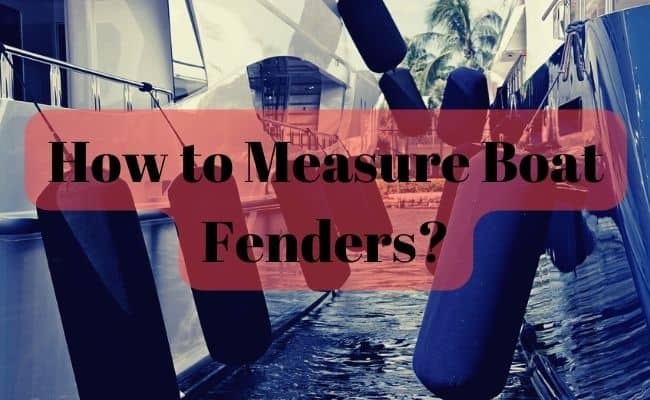How to Measure Boat Fenders? When measuring boat fenders, you should measure the circumference of the fender, not the length. A standard tape measure may kink during the measurement process, so it is a good idea to use a soft tape measure instead. Alternatively, you can use a yardstick to measure the length. It is important to have several measurements of your boat’s fenders to ensure that they fit properly.
After you have the length and width of your boat, you can now measure the fenders. Most boaters will hang their fenders evenly. They should be placed along the widest part of the boat, which will touch the dock first. The fender section closest to the jetty should have the largest number of fenders, and the transom should have the least number of fenders. If you plan to spend a lot of time docking your boat, you should have spares.
Another important factor to consider when measuring boat fenders is where they are going to be placed. Fenders are designed to protect boats from damage, so they should be placed where there is a risk of damage. Usually, they attach to handrails or railings. You should be able to see where the fender will be hanging when you get there. The fender should be secured with a winch or clamp, and it should not stick out of the railing.
How Do You Measure a Fender Cover?
First, you must measure your fenders’ diameter (O) and height (H/L) in centimeters. Do this with a tape measure. You should use a soft tape measure to avoid inaccurate measurements. You can also use a yardstick to measure the length of the fenders.
Line up the fender’s rope hole. Then, use a safety pin or paper clip to draw a straight line through the hole. If you don’t have a safety pin or paper clip, you can use an elastic opening to draw the line.
After you’ve determined the length, the next step is to cut the fender cover. The fender should fit snugly. The length should include the attachment ring at the crotch end. This step can also be done with a pair of sweatpants.
Once you’ve measured your fenders, you can start shopping for a new fender cover. You can find a variety of styles and colors of fender covers, but the Calderon fender cover is an excellent choice. It measures 35″ by 57″ and provides excellent protection against spills, dirt, and scratches. It comes in red, orange, or gray colors.
How Big Is a Size 1 Fender?
One option is a size 1 fender, which is perfect for boats that have limited stowage space. Number 1 Mudguard measures 12 cm x 45 cm. Moreover, they have a solid core and are suitable for heavy marine use.
These fenders are available in custom and standard sizes. When selecting a fender, always remember to check the sizing chart. Most fenders are designed to fit the boat’s length and width, but you should also consider your boat’s needs.
Another option is a traditional fender, which is slim and doesn’t need extra lines to tie them down. It is ideal for boats that are 20 feet or under. Those with more length should consider a six-inch fender. A larger boat will need an eight-inch fender.
Fenders should be mounted horizontally, if possible. This will avoid the fender snagging the boat piling. A vertical fender, on the other hand, would cause it to fall to one side of the piling. In any case, the fender should be tied in half with a hook.
What Size Is an F3 Fender?
If you’re thinking about adding a fender to your boat, you might be wondering what size will fit your boat. Fenders come in different sizes, depending on the length of your boat. The F3 Fender is designed to fit boats that are between 20 and 30 feet long.
To choose the right size, start with the boat’s freeboard and then determine the length. If you’ve got a high freeboard, you’ll need a longer fender. And if you want to avoid overhanging the fender on your boat, make sure you have extras on hand.
How Many Fenders Should a Boat Have?
Generally, one fender should be attached per 10 feet of waterline, with the stern and bow fenders positioned near the bow and stern. The fenders are best attached with rope, which is short and will minimize friction and wear. The fenders should be staggered so that the entire hull is protected. If they are not staggered, seaweed can grow on them and cause the fender to lose its proper position.
Boat fenders come in various sizes, which depend on the length, width, and weight of the vessel. Larger vessels usually have 27-inch-diameter fenders. Smaller boats can use 21-inch-diameter fenders. However, if your boat is over 35 feet, then you may want to consider a fender with a larger diameter.
Boat fenders are essential for securing your boat. Fenders can help protect your vessel by preventing it from rolling, slipping, and rubbing against docks. Some fenders are designed to be hung vertically, while others are designed to be hung horizontally. Horizontal fenders are great for protecting your boat from the waves and pilings, while vertical fenders are perfect for securing your boat to a dock.
A general rule of thumb is to install two fenders on each side of the boat. Larger boats should have three or four fenders on each side. Having spare fenders on hand is also a good idea. This will help protect your boat from strong winds and rolling swells.
How to Measure Boat Fenders?
To choose the right measure of boat fenders, take into account mooring conditions. In general, three fenders should be enough to protect your boat from the sea and its waves. However, this number can change depending on your boat’s length.
Boats that are under 40 feet should only have three fenders, while boats that are around 40 feet and up should have four or more fenders. If your boat is larger, you may need as many as six. In addition, you should take into account the weight of your boat and the risks involved in mooring it.
Typical Mooring Conditions Dictate Fender Size
A fender is required to protect the ship from mooring forces. The size and type of fender required will depend on the type of mooring and typical mooring conditions. A fender can be on the port or starboard side of the ship. Typical mooring conditions include wind speed, sea conditions, and water depth.
The fender must simultaneously provide quiet and smooth berthing facilities. It should be adjustable so that it can adapt to different mooring conditions. It should also have a load/(de)compression relation that can be arbitrarily set. The maximum height of the compression curve is constrained by the permissible inside overpressure, while the maximum depth of the decompression curve is determined by zero overpressure.
The fender must also have the capacity to absorb the kinetic energy of the berthing ship. It is important to note that excess kinetic energy can cause damage to the vessel, especially on the hull. It may even lead to bent piles and toppled dolphins.
Round Fenders Provide Distance of Separation
There are a few styles available for fender flares. There is the OE style, which is designed to look like they’re straight off of the dealer lot. The other style is the street style, which is separate from the OE and is low profile.
There’s also the Bolt style, which gives the appearance of an attachment to the fender. Many people prefer the Bolt style over the OE style. You can even find extreme versions of the Bolt style, which is also called a pocket style.
Round fenders are a popular choice for larger powerboats and commercial vessels. These fenders also protect a stern-to-marina docking. They’re easy to install and come in various sizes. Typically, two-eye cylindrical fenders have molded-in fairleads on both ends. They can be hung vertically or horizontally.
Transom-mounted fenders are also available, which protect a boat docked stern-to-marina. There are even Rafting Cushions, which are a popular choice for rafting multiple boats together. They have two rows of center holes, a large surface area, and six independent molded tubes.
Inflatable Sphere Fenders are Difficult to Store
While you can find a variety of different inflatable sphere fenders to fit your boat’s needs, there are some limitations with this type of fender. They are difficult to store and choose the right size, and they can be difficult to inflate and deflate. They are best used on boats with a relatively flat hull.
Fender size should depend on several factors, including your boat’s weight and location. For example, a boat that’s regularly in rough water will need a larger fender than one that’s used in calm waters. It’s also important to choose the right size if you plan on rafting with other boats. Moreover, different boats have different freeboards and hull flares.
Fenders can be used either horizontally or vertically on a boat. The placement depends on the size of your boat, but they can be stored on a fender rack or under a seat. You should choose a rack that allows you to arrange your fenders without interfering with your boat’s space. If you want to display the sturdiness of your fenders, you can choose a permanent rack. If you’d prefer to store them in a drawer or in a storage locker, folding fender racks are also a good option.

